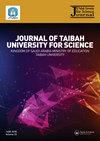Phytochemical studies on Arecaceae growing in Al-Madinah Al-Munawarah, Saudi Arabia
IF 4.1
3区 综合性期刊
Q2 MULTIDISCIPLINARY SCIENCES
引用次数: 0
Abstract
Arecaceae belongs to monocotyledons with around 217 genera. In Saudi Arabia, two genera of Arecaceae are recorded, namely, Hyphaena and Phoenix. Al-Madinah Al-Munawarah is an important region in the western part of Saudi Arabia. This study aimed to investigate the significance of phytochemical traits in Arecaceae plants growing in the region of Al-Madinah Al-Munawarah. Plant specimens were collected in September 2021 from the Al-Madinah Al-Munawarah region. Leaves and fruit samples were screened using standard techniques for the presence of phytochemical groups. For the estimation of antioxidants, extracts were obtained from leaves and the concentration of phenolics and flavonoids was determined by LC-DAD at 335 nm and characterized by LTQ-XL linear Ion Trap LC-MS. In statistical analyses, all data obtained from phytochemical investigations were transferred to numerical characters and used in the multivariate statistical package (MVSP). In phytochemical screening, the phytochemical groups of leaves were useful to differentiate between cultivars of date palms. The presence or absence of tannin and saponin in fruits was useful to distinguish between Ph. dactylifera and H. thebaica. The leaves of Ph. dactylifera cultivars and H. thebaica contained flavonoid compounds with different concentrations. The leaves of Phoenix dactylifera cultivars and Hyphaena thebaica can be a valuable source of natural antioxidants and protect against several diseases because of the abundance of flavonoids. The high concentration of phenolics and flavonoids among date palm cultivars was in Altaibat (5.88 mg/g) while the lowest concentration was found in Safawi (1.54 mg/g). The concentration of phenolics and flavonoids in H. thebaica was 5.02 mg/g.沙特阿拉伯Al-Madinah Al-Munawarah地区槟榔科植物化学研究
槟榔科属单子叶植物,约有217属。在沙特阿拉伯,记录了槟榔科的两属,即Hyphaena和Phoenix。麦地那穆纳瓦拉是沙特阿拉伯西部的一个重要地区。本研究旨在探讨Al-Madinah Al-Munawarah地区槟榔科植物的植物化学性状的意义。植物标本于2021年9月在Al-Madinah Al-Munawarah地区采集。叶子和果实样品使用标准技术筛选植物化学基团的存在。采用LC-DAD法测定叶片中酚类物质和黄酮类物质的浓度,并用LTQ-XL线性离子阱LC-MS进行表征。在统计分析中,从植物化学调查中获得的所有数据都转换为数字字符,并用于多元统计包(MVSP)。在植物化学筛选中,叶片的植物化学基团对枣树品种的区分很有帮助。果实中单宁和皂苷的存在与否可作为区分紫檀和黄芩的重要依据。dactylifera和thebaica品种叶片中含有不同浓度的黄酮类化合物。由于含有丰富的黄酮类化合物,凤尾草和白花凤尾草的叶子是一种宝贵的天然抗氧化剂,可以预防多种疾病。黄酮类化合物和酚类物质含量最高的品种为Altaibat (5.88 mg/g),最低的品种为Safawi (1.54 mg/g)。黄芩中酚类和黄酮类化合物的含量为5.02 mg/g。
本文章由计算机程序翻译,如有差异,请以英文原文为准。
求助全文
约1分钟内获得全文
求助全文
来源期刊

Journal of Taibah University for Science
MULTIDISCIPLINARY SCIENCES-
CiteScore
6.60
自引率
6.10%
发文量
102
审稿时长
19 weeks
期刊介绍:
Journal of Taibah University for Science (JTUSCI) is an international scientific journal for the basic sciences. This journal is produced and published by Taibah University, Madinah, Kingdom of Saudi Arabia. The scope of the journal is to publish peer reviewed research papers, short communications, reviews and comments as well as the scientific conference proceedings in a special issue. The emphasis is on biology, geology, chemistry, environmental control, mathematics and statistics, nanotechnology, physics, and related fields of study. The JTUSCI now quarterly publishes four issues (Jan, Apr, Jul and Oct) per year. Submission to the Journal is based on the understanding that the article has not been previously published in any other form and is not considered for publication elsewhere.
 求助内容:
求助内容: 应助结果提醒方式:
应助结果提醒方式:


